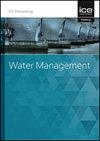Effects of collars on local scour around semi-circular end bridge abutments
IF 0.9
4区 工程技术
Q3 ENGINEERING, CIVIL
Proceedings of the Institution of Civil Engineers-Water Management
Pub Date : 2023-01-31
DOI:10.1680/jwama.21.00011
引用次数: 0
Abstract
The occurrence of scour around bridge elements by the transportation of bed material during flood events can cause serious structural damages and loss of lives. Furthermore, increased uncertainty of precipitation and runoff prediction due to climate change makes this phenomenon more complex and dangerous nowadays. So, bridge scour countermeasures should be more focused on decreasing scour formation around bridge elements. In this study, abutment scour under clear-water conditions with constant flow intensity was conducted and collars were tested as scour countermeasures around semi-circular end bridge abutments. The experimental study was performed in a rectangular channel with an almost uniform cohesionless bed material for 3 h with and without collars. Collars of various lengths located at different elevations around the abutments were tested to investigate the effect of collars on scour development. Based on the experimental results of the study, it was concluded that scour depths decreased with increasing collar width and the collar was placed below the bed level for a given abutment length. The results of this study were compared with those of similar earlier studies to show the effect of abutment shape, size of the bed sediment and test durations on the development of scour depth around the abutments.围护圈对半圆端桥台局部冲刷的影响
洪涝灾害期间,由于河床物质的搬运而产生的桥梁构件冲刷会造成严重的结构破坏和人员伤亡。此外,由于气候变化,降水和径流预测的不确定性增加,使这种现象更加复杂和危险。因此,桥梁冲刷对策应侧重于减少桥梁构件周围冲刷的形成。本研究进行了等流强清水条件下桥台冲刷试验,并在半圆形端部桥台周围进行了环圈冲刷对策试验。实验研究是在矩形槽内进行的,槽内为几乎均匀的无粘结床料,带和不带环。通过在桥台周围不同高度设置不同长度的桥墩,研究桥墩对冲刷发展的影响。试验结果表明,在一定的桥台长度下,随着接箍宽度的增加,冲刷深度减小;本研究的结果与早期类似的研究结果进行了比较,显示了桥台形状、河床沉积物大小和试验时间对桥台周围冲刷深度发展的影响。
本文章由计算机程序翻译,如有差异,请以英文原文为准。
求助全文
约1分钟内获得全文
求助全文
来源期刊
CiteScore
2.10
自引率
0.00%
发文量
28
审稿时长
6-12 weeks
期刊介绍:
Water Management publishes papers on all aspects of water treatment, water supply, river, wetland and catchment management, inland waterways and urban regeneration.
Topics covered: applied fluid dynamics and water (including supply, treatment and sewerage) and river engineering; together with the increasingly important fields of wetland and catchment management, groundwater and contaminated land, waterfront development and urban regeneration. The scope also covers hydroinformatics tools, risk and uncertainty methods, as well as environmental, social and economic issues relating to sustainable development.

 求助内容:
求助内容: 应助结果提醒方式:
应助结果提醒方式:


